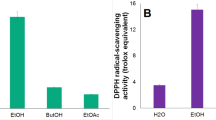Abstract
The antioxidant and antiviral activities ofEuphorbia thymifolia L. (Euphorbiaceae) were investigated in this study. The results showed that all of the fractions (MeOH, CHCl3, EtOAc, n-butanol and water) and pure compounds (3-O-galloyl-4,6-(S)-HHDP-D-glucose, rugosin B and 1,3,4,6-tetra-O-galloyl-K-β-D-glucose)tested possessed antioxidant activities, with the exception of the organic aqueous fraction in the anti-lipid and anti-super-oxide formation assays. The range of IC50 of anti-lipid formation, anti-superoxide formation and free radical scavenging assays for all fractions and pure compounds were 2.81–7.63, 0.03–2.18 and 0.013–2.878 mg/ml, respectively. Electron spin resonance studies showed that water extract and pure compounds ofE. thymifolia exhibited superoxide radical and hydroxyl radical scavenging activities. Besides antioxidant activities, 3-O-galloyl-4,6-(S)-HHDP-D-glucose and EtOAc fraction also showed anti-HSV-2 activity. Thus,E. thymifolia was concluded to possess antioxidant and anti-HSV-2 activities.
Similar content being viewed by others
References
Akaike T, Suga M, Maeda H. Free radical in viral pathogenesis: Molecular mechanisms involving superoxide and NO. Proc Soc Exp Biol Med 217:64–73;1998.
Badway JA, Karnovsky ML. Active oxygen species and the functions of phagocytic leukocytes. Annu Rev Biochem 49:695–726;1980.
Bajaj AK, Govil DC, Bhargava SN. Contact dermatitis due to plants. Indian J Dermatol Venereol 48:268;1982.
Burleson FG, Chambers TM, Wiedbrauk DL. Plaque assay. In: Burleson FG, Chambers TM, Wiedbrauk DL, eds. Virology: A Laboratory Manual. California, Academic Press, 74–84;1992.
Chang WS, Chang YH, Lu FJ, Chiang HC. Inhibitory effects of phenolics on xanthine oxidase. Anticancer Res 14:501–506;1994.
Hwang EI, Ahn BT, Lee HB, Kim YK, Lee KS, Bok SH, Kim YT, Kim SU. Inhibitory activity for chitin synthase II fromSaccharomyces cerevisiae by tannins and related compounds. Planta Med 67:501–504;2001.
Jabbar A, Khan GAMS. Antimicrobial alkaloids fromEuphorbia thymifolia. Pakistan J Sci Industr Res 8:293;1965.
Khan NH, Rahman M, Nur-e-Kamal MS. Antibaterial activity ofEuphorbia thymifolia Linn. Indian J Med Res 87:395–397;1988.
Kirtikar KR, Basu BD. Indian medicinal plants, 2nd ed (reprint), vol III (Beshan Singh, Mehendra Mehendra Pal Singh) pp 2199;1975.
Kohno M, Yamada M, Mitsuta K, Mizuta Y, Yoshikawa T. Spin-trapping studies on the reaction of iron complex with peroxides and the effect of water-soluble antioxidants. Bull Chem Soc Jpn 64:1447–1453;1991.
Kuo YC, Chen CC, Tsai WJ, Ho YH. Regulation of herpes simplex virus type 1 replication in Vero cells byPsychotria serpens: Relationship to gene expression, DNA replication, and protein synthesis. Antiviral Res 51:95–109;2001.
Lal S, Gupta I. Control of sarcoptic mange withChotidudhi (Euphorbia prostrato Ait. andEuphorbia thymifolia Linn.) A preliminary report (abstract). Indian J Pharmacol 2:28;1970.
Lee SH, Tanaka T, Nonaka GI, Nishioka I. Hydrolysable tannins fromEuphorbia thymifolia. Phytochemistry 29:3621–3625;1990.
Lin CC, Hsu YF, Lin TC. Antioxidant and free radical scavenging effect of the tannins ofTerminalia catappa L. Anticancer Res 21:237–244;2001.
Lin CC, Yen FL, Hsu FF, Lin JM. Anti-hypercholesterolaemia, antioxidant activity and free radical scavenger effects of traditional Chinese medicine prescriptions used for stroke. J Pharm Pharmacol 52:1387–1393;2000.
Lin JM, Lin CC, Chen MF, Ujiie T, Takada A. Scavenging effects ofMallotus repandus on oxygen species. J Ethanopharmacol 46:175–181;1995.
Logu AD, Loy G, Pellerano ML, Bonsignore L, Schivo ML. Inactivation of HSV-1 and HSV-2 and prevention of cell-to-cell virus spread bySantolina insularis essential oil. Antiviral Res 48:177–185;2000
Masaol HM, Yang XW, Miyashiro H, Namba T. Inhibitory effect of monomeric and dimeric phenylpropanoids from mace on lipid peroxidation in vivo and in vitro. Phytother Res 7:395–401;1993.
McCord JM, Fridovich I. Superoxide dismutase. Anenzymic function for erythrocuprein (hemo cuprein). J Biol Chem 244:6049–6055;1969.
Mitsuta K, Mizuta Y, Kohno M, Hiramatsu M, Mori A. The application of ESR spin-trapping technique to the evaluation of SOD-like activity of biological substances. Bull Chem Soc Jpn 63:187–191;1990.
Moskovitz J, Yim MB, Chock PB. Free radicals and disease. Arch Biochem Biophys 397:354–359;2002.
Niki E. Antioxidants, free radicals and histological defence. In: Niki E, Shimasaki H, Mino M. eds. Japan Scientific Societies Press, Tokyo, pp. 3;1995.
Oda T, Akiake T, Hamamoto T, Suzuki F, Hirano T, Maeda H. Oxygen radical in influenza-induced pathogenesis and treatment with pyran polymer-conjugated SOD. Science 244:974–976;1989.
Offord E, van Poppel G, Tyrrell R. Markers of oxidative damage and antioxidant protection: Current status and relevance to disease. Free Radic Res 33:S5–19;2000.
Ohkawa H, Ohishi N, Yagi K. Assay for lipid peroxides in animal tissue by thiobarbituric acid reaction. Anal Biochem 95:351–358;1979.
Pauwels R, Balzarini J, Baba M, Snoeck R, Schols D, Herdewijn P, Desmyter J, Clercq ED. Rapid and automated tetrazolium-based colorimetric assay for the detection of anti-HIV compounds. J Virol Methods 20:309–321;1988.
Rao VR, Gupta I. In vitro studies on the antifungal activity of some indigenous drugs againstTrichophyton mentagrophytes (abstract). Indian J Pharmacol 2:27;1970.
Schinella GR, Tournier HA, Prieto JM, Mordujovich D, Rios JL. Antioxidant activity of anti-inflammatory plant extracts. Life Sci 70:1023–1033;2002.
Scudiero DA, Shoemaker RH, Paull KD, Monks A, Tiemey S, Nofziger TH, Currens MJ, Seniff D, Boyd MR. Evaluation of a soluble tetrazolium/formazan assay for cell growth and drug sensitivity in culture using human and other tumor cell lines. Cancer Res 48:4827–4833;1998.
Shiota S, Shimizu M, Mizusima T, Ito H, Hatano T, Yoshida T, Tsuchiya T. Restoration of effectiveness of beta-lactams on methicillin-resistantStaphylococcus aureus by tellimagrandin I from rose red. FEMS Microbiol Lett 185:135–138;2000.
Stadtman ER. Protein oxidation in aging and age-related diseases. Ann NY Acad Sci 928:22–38;2001.
Vuillaume M. Reduced oxygen species, mutation, induction and cancer initiation. Mutat Res 186:43–72;1987.
Weislow OS, Kiser R, Fine DL, Bader J, Shoemaker RH, Boyd MR. New soluble-formazan assay for HIV-1 cytopathic effects: Application to high-flux screening of synthetic and natural products for AIDS-antiviral activity. J Natl Cancer Inst 81:577–86;1989.
Young IS, Woodside JV. Antioxidants in health and disease. J Clin Pathol 54:176–186;2001.
Yu JW, Yoon SS, Yang R. Iron chlorin e6 scavenges hydroxyl radical and protects human endothelial cells against hydrogen peroxide toxicity. Biol Pharm Bull 24:1053–1059;2001.
Author information
Authors and Affiliations
Rights and permissions
About this article
Cite this article
Lin, CC., Cheng, HY., Yang, CM. et al. Antioxidant and antiviral activities ofEuphorbia thymifolia L.. J Biomed Sci 9, 656–664 (2002). https://doi.org/10.1007/BF02254994
Received:
Accepted:
Issue Date:
DOI: https://doi.org/10.1007/BF02254994




